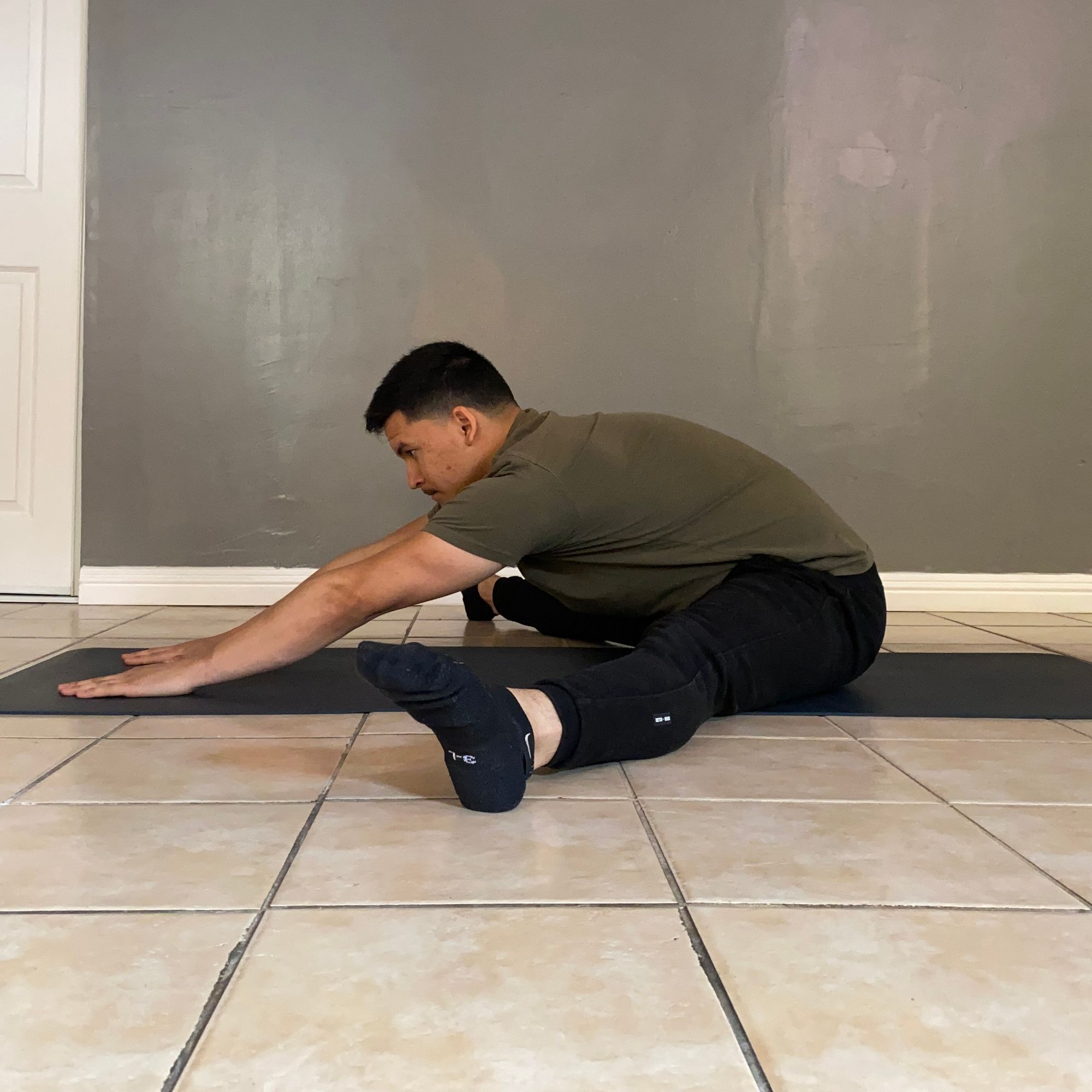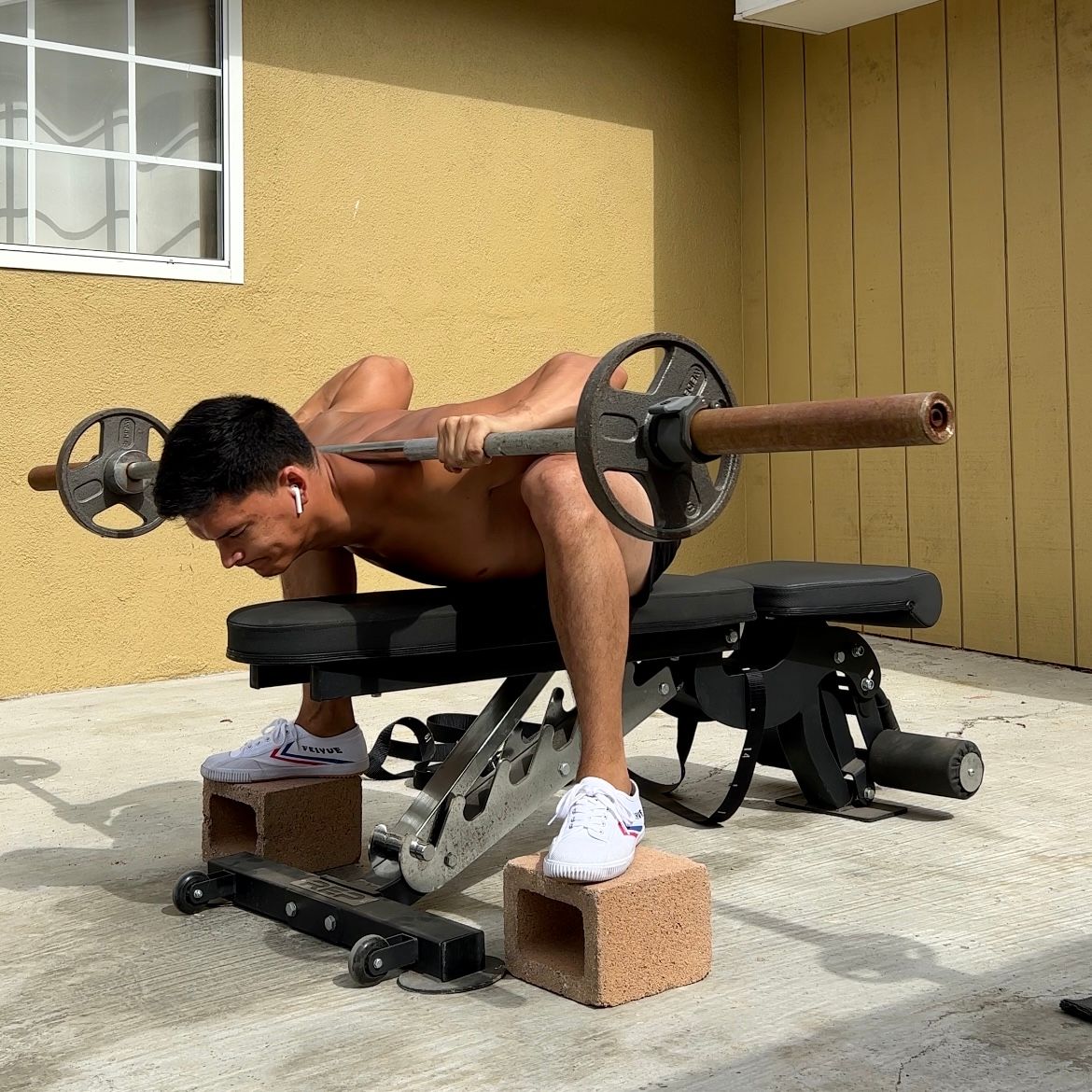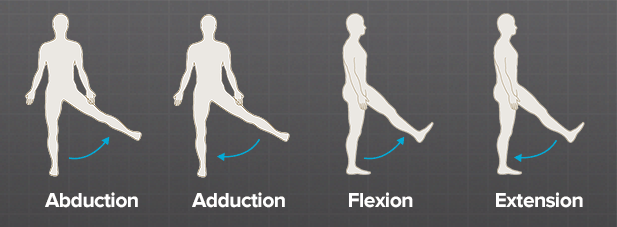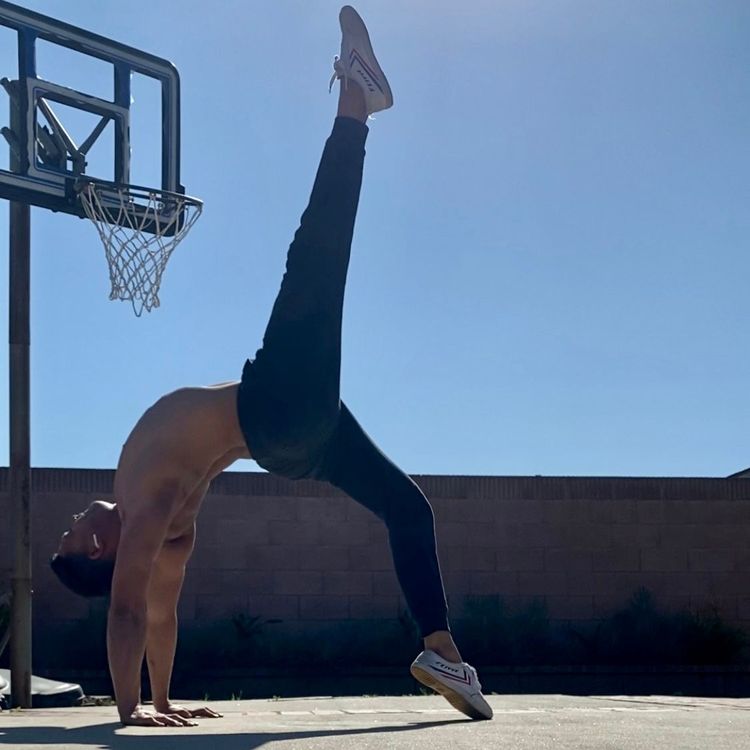How To Use The Seated Goodmorning for Improving Pancake Flexibility

The purpose of this article is to explain how the Seated Goodmorning can be used as a supplementary exercise for developing pancake flexibility.
The seated goodmorning is an extraordinary exercise that tends to fall on the unconventional side of barbell lifts. Many see it as unconventional because of the demand on the lower back as well as the demand on hip flexibility, but this is part of what makes it a great movement!
The more traditional standing variation was used heavily by the legendary Louie Simmons at Westside Barbell to build world-class posterior chain strength in his athletes. Louie famously said that "a weak back equals a weak man" and standing goodmornings were regularly part of his athlete's max effort lifts on Mondays. They used the goodmorning to pack some massive numbers on their squats. The seated goodmorning was a favorite of Charles Poloquin, who found that the seated variation fixed the body into a position that promotes good technique.
However, not only is the seated goodmorning a great exercise for developing serious strength in the posterior chain, but it's also effective for developing serious flexibility in the posterior chain. It's easily one of my favorite exercises to help develop the pancake and more specifically, the ability to anteriorly tilt our hips in a pancake.
The purpose of this article is to explain why the seated goodmorning is a great supplementary exercise for pancake training, the key details for performing it, as well as progressions and variations.
Why The Seated Goodmorning for Pancake
One of the most sought-after flexibility positions is the pancake. You can see it in the first image below. And rightfully so! A textbook pancake showcases superior flexibility across the entire posterior chain: Hamstrings, adductors, glutes, and lower back. As well as demonstrates strength through the anterior chain as strong hip flexors are required to pull the torso into a compressed chest-to-floor position. This combination makes the position very transferable to many complex gymnastic skills such as the straddle and stalder press to handstand, as well as many compressed positions seen in pole, aerial, and other sports.
A textbook pancake will have the chest on the floor with a neutral spine. "A flat back" as most people would say. In order to get a flat back in a pancake, the hips must roll forward, or tilt anteriorly as much as possible. This forward rolling of the hips provides slack to our back musculature, facilitating extension of the back, i.e. the flat back we're looking for. And the seated goodmorning when trained with certain key details in mind is an effective exercise to develop this anterior pelvic tilt (APT). You can see in the middle picture below how the bottom of the seated goodmorning looks almost identical to the pancake. The only difference is the bent knees and elevated hips. It's these two differences that make it so great for developing the anterior tilt needed for a flat-back pancake.
When we're seated on the floor with legs straight and our torso leaning forward, our hamstrings and adductors are in a very lengthened position. This is why we feel the stretch somewhere on the back of the legs as soon as we sit in a pancake. The sensation we feel on the back of the legs takes over, making it difficult to anteriorly tilt our hips. This often results in the very much dreaded round back, as seen in the third picture below. However, a round back is nothing to dread or be alarmed about. A round back is expected for most people in their pancake journey and will present itself this way in the actual press to handstand. But, this is where the seated goodmorning comes in to save the day.
By sitting on a bench our hips will be high enough to bend at the knees. Bending the knees significantly reduces the stretch on the back of the legs allowing us to focus heavily on our hips anterior pelvic tilt. This is the glory of the seated goodmorning! An easy way to train our anterior pelvic tilt while we work the other aspects of the pancake through more traditional methods on the floor. It's not the only way to improve our hips ability to tilt anteriorly, but it's certainly an effective way.



Key Details
The 3 key details below are how I personally train and teach the seated goodmorning for improving pancake flexibility. This differs from how it would be coached in bodybuilding/powerlifting circles. This is my approach from the lens of a flexibility coach.
1) Anterior Pelvic Tilt
Nothing is more important in the seated goodmorning than our hips' anterior pelvic tilt. This is a hip movement. All movement must happen at the hips. The hips act as a fulcrum in the movement. We need to constantly be thinking about rolling our hips as much as possible. From the point that we sit on the bench and set up the movement, all the way through the last rep. You can see in the clip below how I'm trying to rotate my hip anteriorly (counterclockwise in this case) from the moment I sit on the bench. It's a subtle shuffle of my hips. This is critical during the setup.
When we first sit on the bench, our bum is pointing downward right into the bench. We need to roll our hips along the bench with the intention of pointing our bum backward. Imagine trying to twerk your lower back. Quite literally try to exaggerate the hip tilt. It may feel wrong and even awkward to set up this way, but this is why it's so effective at improving APT.
Make sure to film yourself. You may not see a clear hip rotation when you first start but keep the intention throughout your training, and over time your ability to tilt will improve.
2) Back Position
The back position is simple. Maintain a neutral or slightly arched back throughout the movement. I actually find it helpful to actively think of arching the lower back to encourage more hip tilt. Along with the slightly arched back, we also want to depress and retract our shoulder blades. Keep the upper back engaged. It's simple but critical.
Rounding the lower back will put our hips in a posterior pelvic tilt. There are great seated good morning variations that call for a round back. But when training the seated pancake with flexibility in mind, an anterior pelvic tilt is our best friend.
3) Load
How much weight should we put on the bar? My recommendation here is to use just enough weight to allow you to get more APT than if you were to use no weight. I'm not at all against loading this movement. In fact, I enjoy loading it up. And like I mentioned in the introduction, big-time lifters have used to goodmorning to increase their squat strength. But if our goal is to work on our ability to tilt our hips, then less weight may before effective for a period of time. As the weight on the bar increases, it becomes more challenging to maintain an extended spine. Too much weight encourages rounding of the back which will also encourage a posterior pelvic tilt. This is the opposite effect of what we intended. Therefore rounding of the back may be a sign that too much weight is being used.
Once we've made progress on our hip tilt and are satisfied with the shape of our back in our pancake, it's time to load it up! Working cycles with lower reps and higher weights is a great idea at this point to continue challenging and strengthening the new range.
4) Bar Placement and Hand Position
Place the bar onto the meaty part of the traps or just below. If the bar is positioned too high it makes it easy for the bar to slide upward and will encourage rounding of the back.
The hands have two options for holding the bar. One option is to hold the bar in the same place you would in a back squat and the second option is to hold the bar from collar to collar. Collar to collar is often the preferred method as it securely locks the bar in place. However, I personally prefer the first option. The lats are in a shorter position when the hands are closer to the body on the barbell. This makes me feel like I can engage my entire back more and it feels safer when adding more weight. But I encourage you to try both options and find the one that you prefer.
You can see the collar to collar position in the picture below.

Progressions
1. Bent Knee Target Assisted
Since our primary focus with the seated good morning is flexibility related, we want our progress to be focused on increasing range of motion over time. One idea is to use tasking as a way to objectively measure our progress.
To do this, sit with the bench between the legs and with enough of the bench in front of you that you can place yoga blocks on the bench. The task will be to lower down and touch the blocks with the chest on each rep. Keeping in mind the importance of APT and a straight/ slightly arched back. Once your chest touches the blocks on each set and rep, decrease the block height and repeat the process. This can be repeated until your chest or belly is touching the bench or your inner thighs.
3 sets of 6-10 reps with a 3010 tempo
After reaching your desired range of motion, it's time to start loading it up! Or, if you find that you reach a plateau on range of motion before reaching your goal, it may be a good option to move on to increasing load as well.
2. Load
Time to load up the barbell and really strengthen the lower back and hamstrings! But as always, focus on slow and steady progressive overload. This is supposed to be a supplementary exercise, not one we want to get hurt doing. That said, after adapting to the exercise, feel free to explore lower rep ranges and higher weights.
3-5 sets of 3-6 reps with a 3010 tempo
Variations
Like all barbell lifts, there are plenty of variations of the goodmorning. Here I'll present two variations that can be useful for working on different aspects of pancake flexibility.
1. Feet elevated
The feet elevated variation has quite a different feel. Elevating the feet increases the amount of flexion at the hips. You can feel the increased demand on the hip flexors right off the bat. What makes this variation great is the opportunity to train hip flexion with bent knees. Bending the knees cuts out much of the demand on the hamstrings and adductors allowing the focus to be on training hip flexion. The pancake itself requires the hips to be in a very compressed position. Especially in a chest or belly-to-floor pancake. Much like the feet elevated seated good morning. One idea is to train this variation for a cycle or two after having spent some time training the standard variation.
2. Straight knees
Extending the knees will lengthen the muscles along the back of the leg and greatly intensify the stretch and demand on the hamstrings and adductors. It's much more similar to the pancake in this regard. The main difference between this variation and the pancake is that the hips are elevated off of the floor. This allows training of the hamstrings and adductors at end range, just at a lower intensity and with more anterior tilt than is accessible on the floor. I recommend starting on a bench and working down from there. The difficulty increases as the height decreases. Once ready to decrease the height, a stepper can come in handy because the height can gradually be decreased over time. The picture below on the right is of me using a stepper on its lowest height.
One thing to note about ankle position. When sitting on a bench it can feel awkward to point the toes. I recommend dorsiflexing the ankle. Pointing the toes will feel much more comfortable as the height decreases. At this point, it's a good idea to train both pointed ankles and flexed ankles. Not at the same time necessarily. It's just a good idea because flexing the ankle increases the stretch on the calf.


Conclusion
Overall, the seated goodmorning is one of my favorite supplementary exercises for improving pancake flexibility and it's a great addition to the program of any range seeker or flexibility enthusiast out there. It's great because it allows us to effectively train the anterior pelvic tilt and straight back aspects of the pancake with bent knees, and its variations, feet elevated and straight knees, are excellent for developing two other important aspects of the pancake. Hip flexion and hamstring flexibility. And it doesn't end there, it's also excellent for developing a superior lower back. It's an all-around bang-for-your-buck exercise and worthwhile to train.
If you enjoyed this article, I encourage you to subscribe to my weekly newsletter, The Sunday Spread, where I share free resources, training tips, discounts on my coaching services, as well as my personal interests like podcasts, books, and worthwhile videos. You can sign up by hitting the gray button in the bottom right-hand corner and dropping your email or signing up on the homepage!






